Technology and Its Impact on Business
VerifiedAdded on 2020/03/02
|13
|3178
|77
AI Summary
This assignment delves into the profound impact of technology across diverse business domains. It examines how technologies like RFID, cloud computing, and online reviews are transforming industries such as healthcare, retail, and service sectors. The analysis covers topics like network security, employee skills evolution, accounting systems modernization, product review dynamics, and the interplay between malware and anti-malware solutions. Furthermore, it investigates the role of customer feedback in shaping business strategies and enhancing customer satisfaction.
Contribute Materials
Your contribution can guide someone’s learning journey. Share your
documents today.
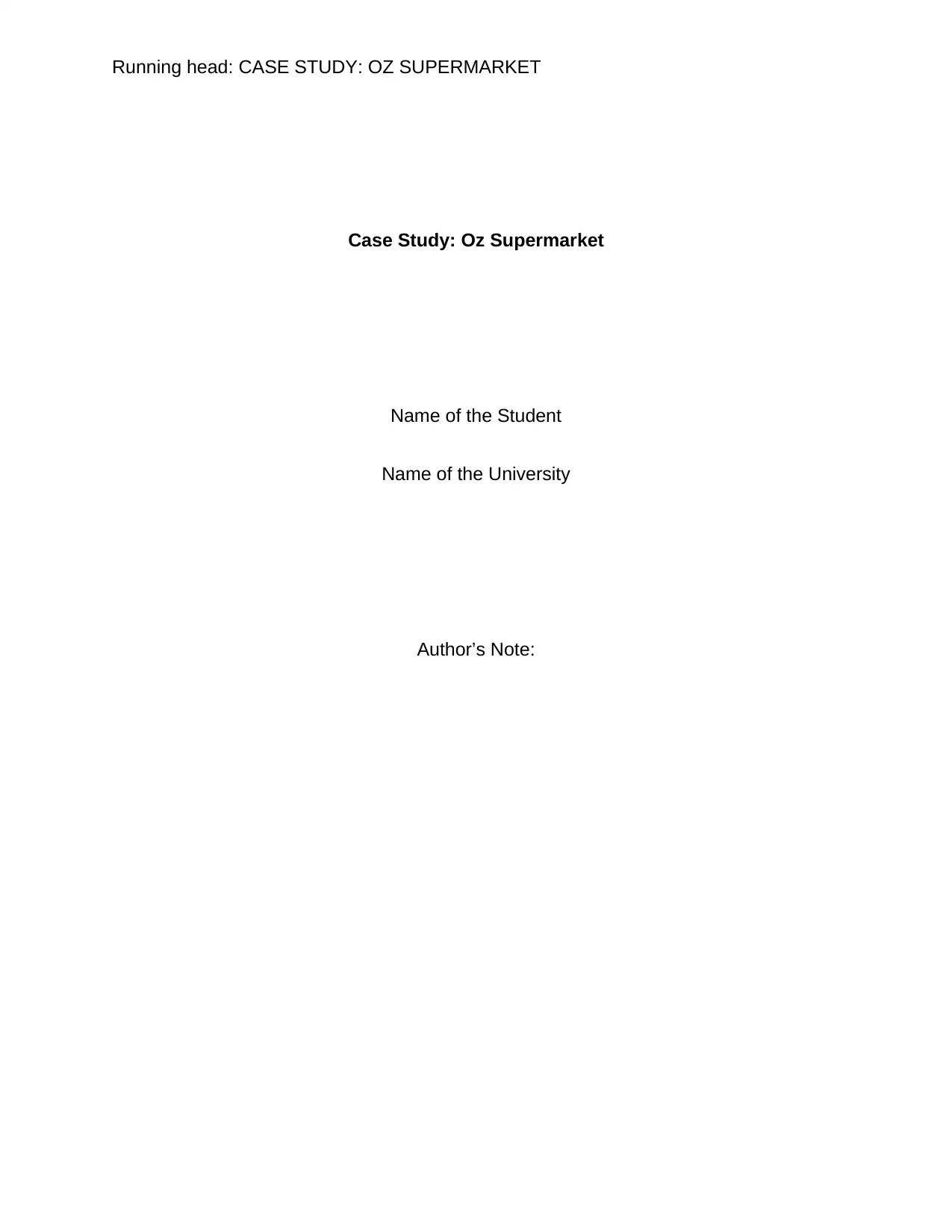
Running head: CASE STUDY: OZ SUPERMARKET
Case Study: Oz Supermarket
Name of the Student
Name of the University
Author’s Note:
Case Study: Oz Supermarket
Name of the Student
Name of the University
Author’s Note:
Secure Best Marks with AI Grader
Need help grading? Try our AI Grader for instant feedback on your assignments.
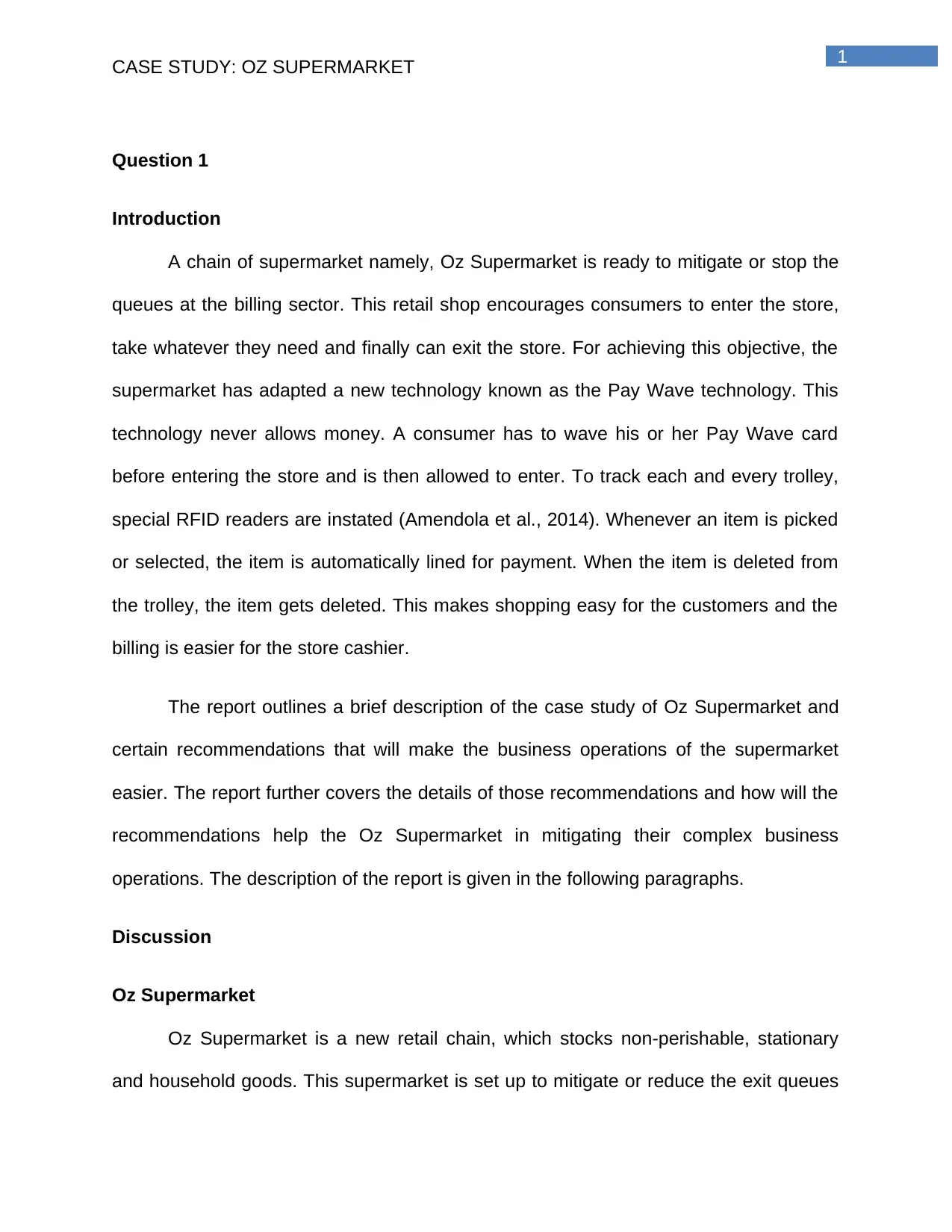
1
CASE STUDY: OZ SUPERMARKET
Question 1
Introduction
A chain of supermarket namely, Oz Supermarket is ready to mitigate or stop the
queues at the billing sector. This retail shop encourages consumers to enter the store,
take whatever they need and finally can exit the store. For achieving this objective, the
supermarket has adapted a new technology known as the Pay Wave technology. This
technology never allows money. A consumer has to wave his or her Pay Wave card
before entering the store and is then allowed to enter. To track each and every trolley,
special RFID readers are instated (Amendola et al., 2014). Whenever an item is picked
or selected, the item is automatically lined for payment. When the item is deleted from
the trolley, the item gets deleted. This makes shopping easy for the customers and the
billing is easier for the store cashier.
The report outlines a brief description of the case study of Oz Supermarket and
certain recommendations that will make the business operations of the supermarket
easier. The report further covers the details of those recommendations and how will the
recommendations help the Oz Supermarket in mitigating their complex business
operations. The description of the report is given in the following paragraphs.
Discussion
Oz Supermarket
Oz Supermarket is a new retail chain, which stocks non-perishable, stationary
and household goods. This supermarket is set up to mitigate or reduce the exit queues
CASE STUDY: OZ SUPERMARKET
Question 1
Introduction
A chain of supermarket namely, Oz Supermarket is ready to mitigate or stop the
queues at the billing sector. This retail shop encourages consumers to enter the store,
take whatever they need and finally can exit the store. For achieving this objective, the
supermarket has adapted a new technology known as the Pay Wave technology. This
technology never allows money. A consumer has to wave his or her Pay Wave card
before entering the store and is then allowed to enter. To track each and every trolley,
special RFID readers are instated (Amendola et al., 2014). Whenever an item is picked
or selected, the item is automatically lined for payment. When the item is deleted from
the trolley, the item gets deleted. This makes shopping easy for the customers and the
billing is easier for the store cashier.
The report outlines a brief description of the case study of Oz Supermarket and
certain recommendations that will make the business operations of the supermarket
easier. The report further covers the details of those recommendations and how will the
recommendations help the Oz Supermarket in mitigating their complex business
operations. The description of the report is given in the following paragraphs.
Discussion
Oz Supermarket
Oz Supermarket is a new retail chain, which stocks non-perishable, stationary
and household goods. This supermarket is set up to mitigate or reduce the exit queues
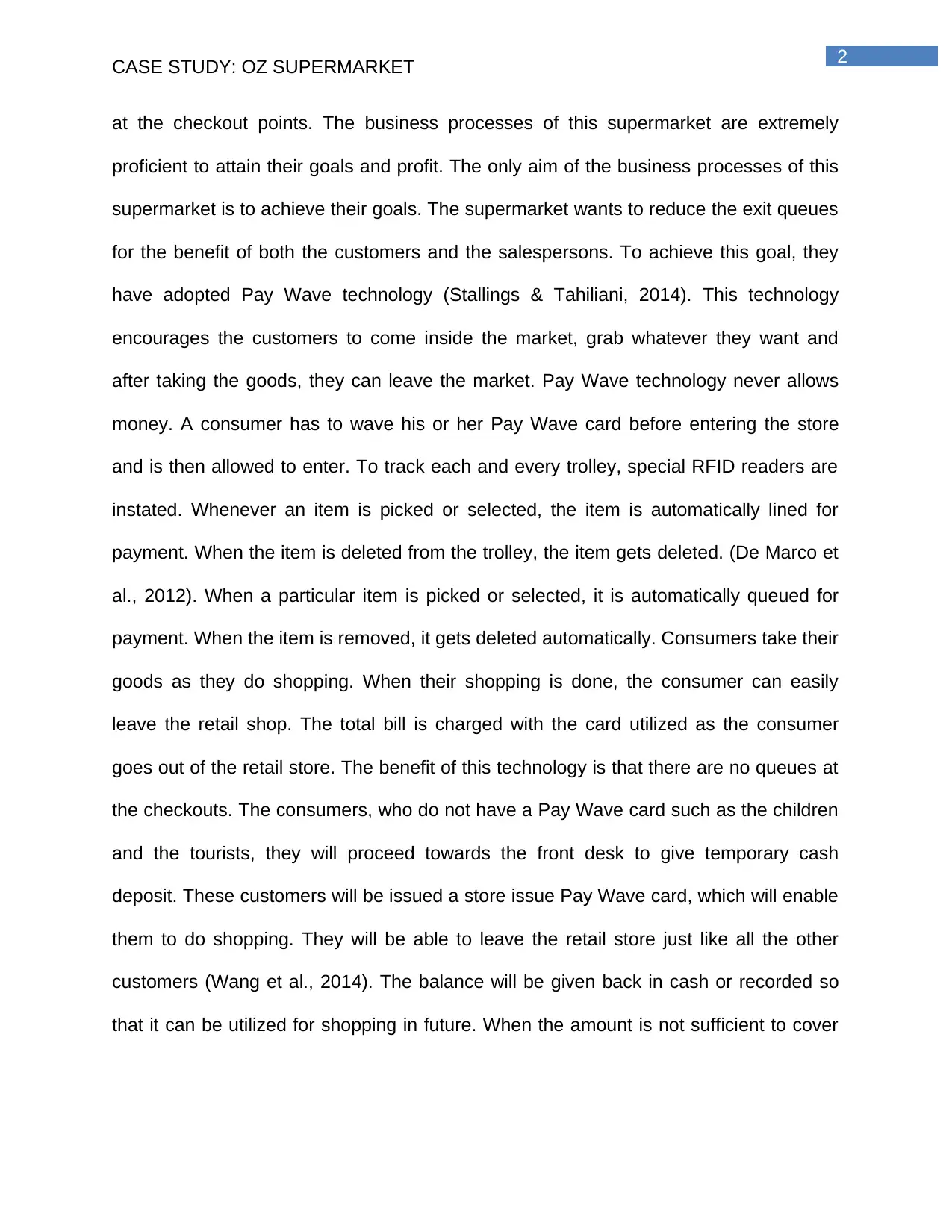
2
CASE STUDY: OZ SUPERMARKET
at the checkout points. The business processes of this supermarket are extremely
proficient to attain their goals and profit. The only aim of the business processes of this
supermarket is to achieve their goals. The supermarket wants to reduce the exit queues
for the benefit of both the customers and the salespersons. To achieve this goal, they
have adopted Pay Wave technology (Stallings & Tahiliani, 2014). This technology
encourages the customers to come inside the market, grab whatever they want and
after taking the goods, they can leave the market. Pay Wave technology never allows
money. A consumer has to wave his or her Pay Wave card before entering the store
and is then allowed to enter. To track each and every trolley, special RFID readers are
instated. Whenever an item is picked or selected, the item is automatically lined for
payment. When the item is deleted from the trolley, the item gets deleted. (De Marco et
al., 2012). When a particular item is picked or selected, it is automatically queued for
payment. When the item is removed, it gets deleted automatically. Consumers take their
goods as they do shopping. When their shopping is done, the consumer can easily
leave the retail shop. The total bill is charged with the card utilized as the consumer
goes out of the retail store. The benefit of this technology is that there are no queues at
the checkouts. The consumers, who do not have a Pay Wave card such as the children
and the tourists, they will proceed towards the front desk to give temporary cash
deposit. These customers will be issued a store issue Pay Wave card, which will enable
them to do shopping. They will be able to leave the retail store just like all the other
customers (Wang et al., 2014). The balance will be given back in cash or recorded so
that it can be utilized for shopping in future. When the amount is not sufficient to cover
CASE STUDY: OZ SUPERMARKET
at the checkout points. The business processes of this supermarket are extremely
proficient to attain their goals and profit. The only aim of the business processes of this
supermarket is to achieve their goals. The supermarket wants to reduce the exit queues
for the benefit of both the customers and the salespersons. To achieve this goal, they
have adopted Pay Wave technology (Stallings & Tahiliani, 2014). This technology
encourages the customers to come inside the market, grab whatever they want and
after taking the goods, they can leave the market. Pay Wave technology never allows
money. A consumer has to wave his or her Pay Wave card before entering the store
and is then allowed to enter. To track each and every trolley, special RFID readers are
instated. Whenever an item is picked or selected, the item is automatically lined for
payment. When the item is deleted from the trolley, the item gets deleted. (De Marco et
al., 2012). When a particular item is picked or selected, it is automatically queued for
payment. When the item is removed, it gets deleted automatically. Consumers take their
goods as they do shopping. When their shopping is done, the consumer can easily
leave the retail shop. The total bill is charged with the card utilized as the consumer
goes out of the retail store. The benefit of this technology is that there are no queues at
the checkouts. The consumers, who do not have a Pay Wave card such as the children
and the tourists, they will proceed towards the front desk to give temporary cash
deposit. These customers will be issued a store issue Pay Wave card, which will enable
them to do shopping. They will be able to leave the retail store just like all the other
customers (Wang et al., 2014). The balance will be given back in cash or recorded so
that it can be utilized for shopping in future. When the amount is not sufficient to cover
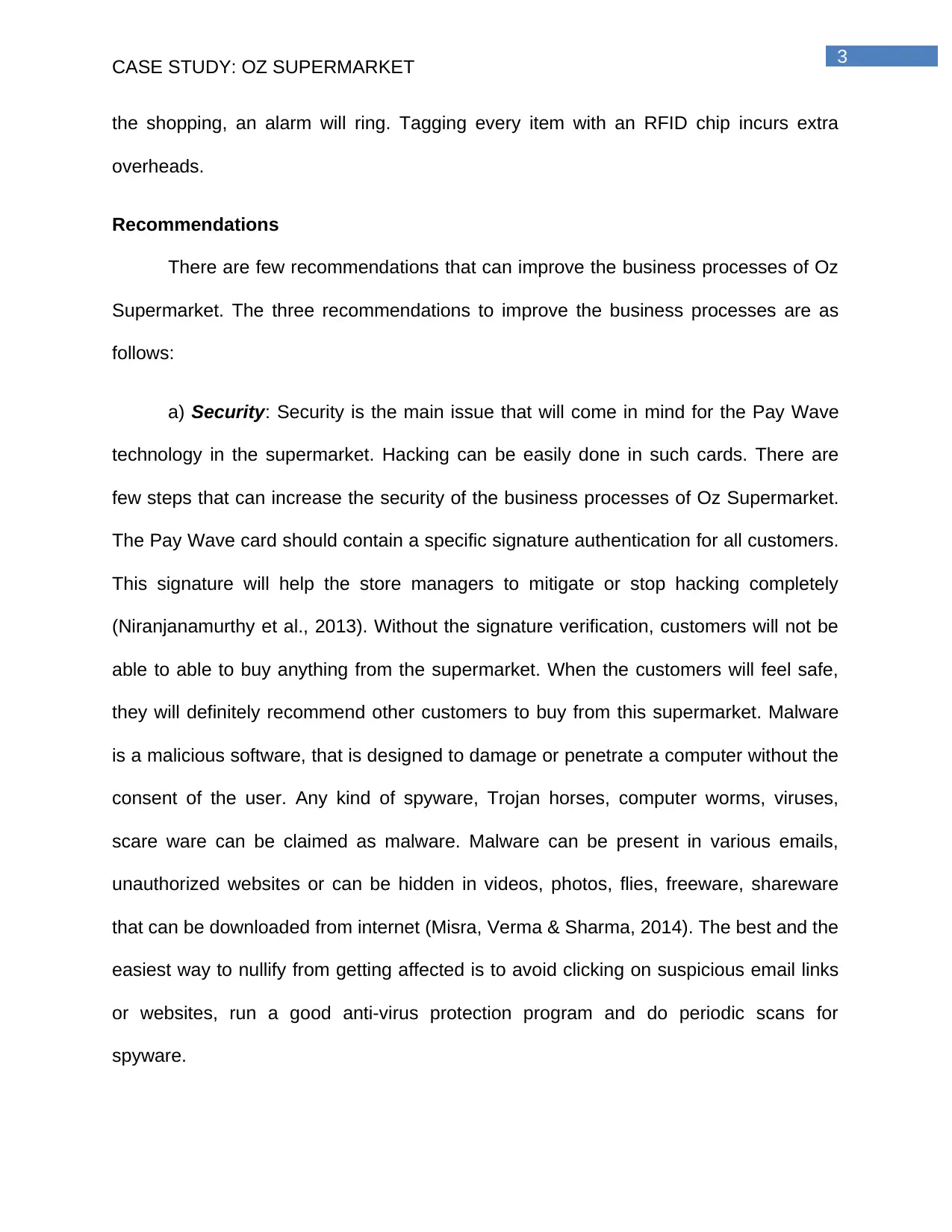
3
CASE STUDY: OZ SUPERMARKET
the shopping, an alarm will ring. Tagging every item with an RFID chip incurs extra
overheads.
Recommendations
There are few recommendations that can improve the business processes of Oz
Supermarket. The three recommendations to improve the business processes are as
follows:
a) Security: Security is the main issue that will come in mind for the Pay Wave
technology in the supermarket. Hacking can be easily done in such cards. There are
few steps that can increase the security of the business processes of Oz Supermarket.
The Pay Wave card should contain a specific signature authentication for all customers.
This signature will help the store managers to mitigate or stop hacking completely
(Niranjanamurthy et al., 2013). Without the signature verification, customers will not be
able to able to buy anything from the supermarket. When the customers will feel safe,
they will definitely recommend other customers to buy from this supermarket. Malware
is a malicious software, that is designed to damage or penetrate a computer without the
consent of the user. Any kind of spyware, Trojan horses, computer worms, viruses,
scare ware can be claimed as malware. Malware can be present in various emails,
unauthorized websites or can be hidden in videos, photos, flies, freeware, shareware
that can be downloaded from internet (Misra, Verma & Sharma, 2014). The best and the
easiest way to nullify from getting affected is to avoid clicking on suspicious email links
or websites, run a good anti-virus protection program and do periodic scans for
spyware.
CASE STUDY: OZ SUPERMARKET
the shopping, an alarm will ring. Tagging every item with an RFID chip incurs extra
overheads.
Recommendations
There are few recommendations that can improve the business processes of Oz
Supermarket. The three recommendations to improve the business processes are as
follows:
a) Security: Security is the main issue that will come in mind for the Pay Wave
technology in the supermarket. Hacking can be easily done in such cards. There are
few steps that can increase the security of the business processes of Oz Supermarket.
The Pay Wave card should contain a specific signature authentication for all customers.
This signature will help the store managers to mitigate or stop hacking completely
(Niranjanamurthy et al., 2013). Without the signature verification, customers will not be
able to able to buy anything from the supermarket. When the customers will feel safe,
they will definitely recommend other customers to buy from this supermarket. Malware
is a malicious software, that is designed to damage or penetrate a computer without the
consent of the user. Any kind of spyware, Trojan horses, computer worms, viruses,
scare ware can be claimed as malware. Malware can be present in various emails,
unauthorized websites or can be hidden in videos, photos, flies, freeware, shareware
that can be downloaded from internet (Misra, Verma & Sharma, 2014). The best and the
easiest way to nullify from getting affected is to avoid clicking on suspicious email links
or websites, run a good anti-virus protection program and do periodic scans for
spyware.
Secure Best Marks with AI Grader
Need help grading? Try our AI Grader for instant feedback on your assignments.
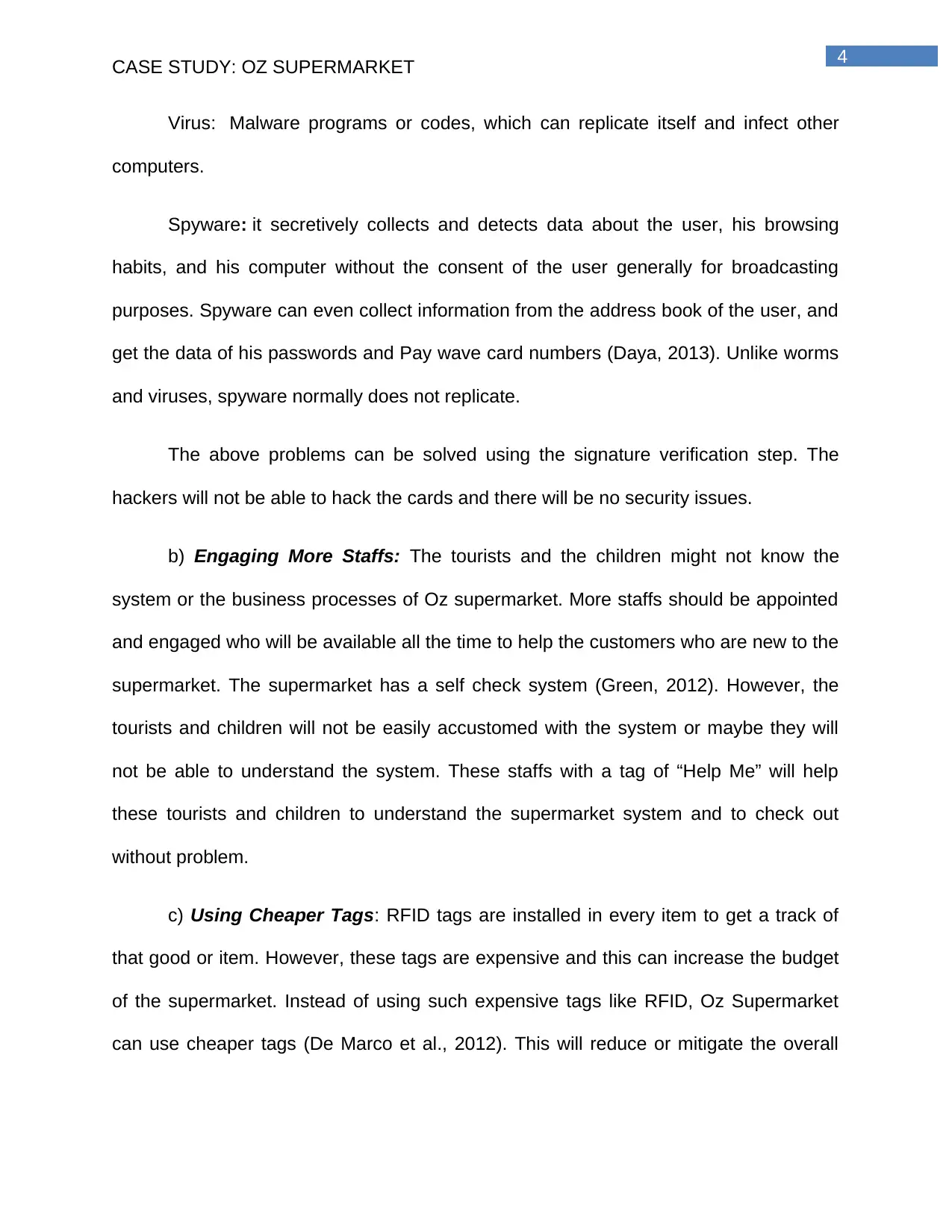
4
CASE STUDY: OZ SUPERMARKET
Virus: Malware programs or codes, which can replicate itself and infect other
computers.
Spyware: it secretively collects and detects data about the user, his browsing
habits, and his computer without the consent of the user generally for broadcasting
purposes. Spyware can even collect information from the address book of the user, and
get the data of his passwords and Pay wave card numbers (Daya, 2013). Unlike worms
and viruses, spyware normally does not replicate.
The above problems can be solved using the signature verification step. The
hackers will not be able to hack the cards and there will be no security issues.
b) Engaging More Staffs: The tourists and the children might not know the
system or the business processes of Oz supermarket. More staffs should be appointed
and engaged who will be available all the time to help the customers who are new to the
supermarket. The supermarket has a self check system (Green, 2012). However, the
tourists and children will not be easily accustomed with the system or maybe they will
not be able to understand the system. These staffs with a tag of “Help Me” will help
these tourists and children to understand the supermarket system and to check out
without problem.
c) Using Cheaper Tags: RFID tags are installed in every item to get a track of
that good or item. However, these tags are expensive and this can increase the budget
of the supermarket. Instead of using such expensive tags like RFID, Oz Supermarket
can use cheaper tags (De Marco et al., 2012). This will reduce or mitigate the overall
CASE STUDY: OZ SUPERMARKET
Virus: Malware programs or codes, which can replicate itself and infect other
computers.
Spyware: it secretively collects and detects data about the user, his browsing
habits, and his computer without the consent of the user generally for broadcasting
purposes. Spyware can even collect information from the address book of the user, and
get the data of his passwords and Pay wave card numbers (Daya, 2013). Unlike worms
and viruses, spyware normally does not replicate.
The above problems can be solved using the signature verification step. The
hackers will not be able to hack the cards and there will be no security issues.
b) Engaging More Staffs: The tourists and the children might not know the
system or the business processes of Oz supermarket. More staffs should be appointed
and engaged who will be available all the time to help the customers who are new to the
supermarket. The supermarket has a self check system (Green, 2012). However, the
tourists and children will not be easily accustomed with the system or maybe they will
not be able to understand the system. These staffs with a tag of “Help Me” will help
these tourists and children to understand the supermarket system and to check out
without problem.
c) Using Cheaper Tags: RFID tags are installed in every item to get a track of
that good or item. However, these tags are expensive and this can increase the budget
of the supermarket. Instead of using such expensive tags like RFID, Oz Supermarket
can use cheaper tags (De Marco et al., 2012). This will reduce or mitigate the overall
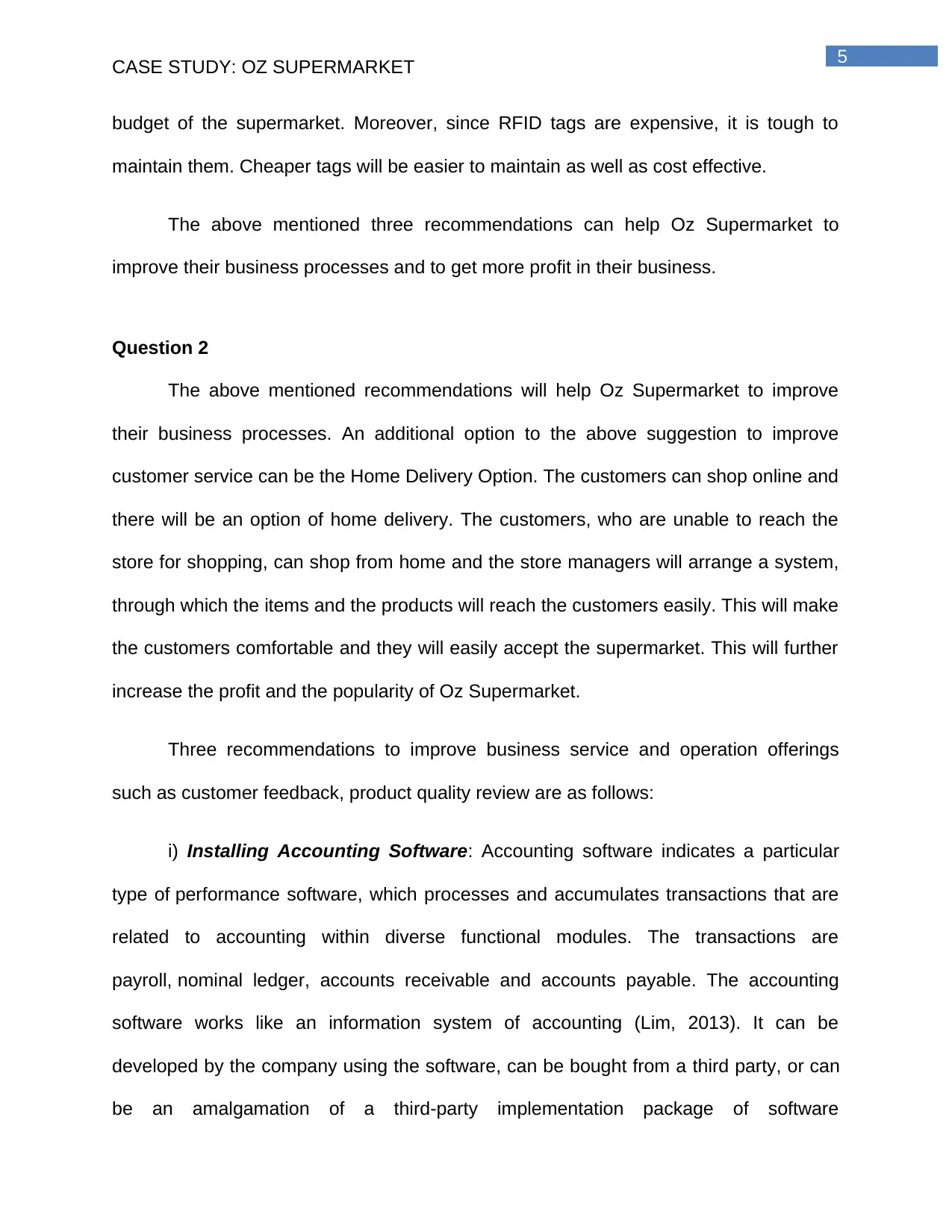
5
CASE STUDY: OZ SUPERMARKET
budget of the supermarket. Moreover, since RFID tags are expensive, it is tough to
maintain them. Cheaper tags will be easier to maintain as well as cost effective.
The above mentioned three recommendations can help Oz Supermarket to
improve their business processes and to get more profit in their business.
Question 2
The above mentioned recommendations will help Oz Supermarket to improve
their business processes. An additional option to the above suggestion to improve
customer service can be the Home Delivery Option. The customers can shop online and
there will be an option of home delivery. The customers, who are unable to reach the
store for shopping, can shop from home and the store managers will arrange a system,
through which the items and the products will reach the customers easily. This will make
the customers comfortable and they will easily accept the supermarket. This will further
increase the profit and the popularity of Oz Supermarket.
Three recommendations to improve business service and operation offerings
such as customer feedback, product quality review are as follows:
i) Installing Accounting Software: Accounting software indicates a particular
type of performance software, which processes and accumulates transactions that are
related to accounting within diverse functional modules. The transactions are
payroll, nominal ledger, accounts receivable and accounts payable. The accounting
software works like an information system of accounting (Lim, 2013). It can be
developed by the company using the software, can be bought from a third party, or can
be an amalgamation of a third-party implementation package of software
CASE STUDY: OZ SUPERMARKET
budget of the supermarket. Moreover, since RFID tags are expensive, it is tough to
maintain them. Cheaper tags will be easier to maintain as well as cost effective.
The above mentioned three recommendations can help Oz Supermarket to
improve their business processes and to get more profit in their business.
Question 2
The above mentioned recommendations will help Oz Supermarket to improve
their business processes. An additional option to the above suggestion to improve
customer service can be the Home Delivery Option. The customers can shop online and
there will be an option of home delivery. The customers, who are unable to reach the
store for shopping, can shop from home and the store managers will arrange a system,
through which the items and the products will reach the customers easily. This will make
the customers comfortable and they will easily accept the supermarket. This will further
increase the profit and the popularity of Oz Supermarket.
Three recommendations to improve business service and operation offerings
such as customer feedback, product quality review are as follows:
i) Installing Accounting Software: Accounting software indicates a particular
type of performance software, which processes and accumulates transactions that are
related to accounting within diverse functional modules. The transactions are
payroll, nominal ledger, accounts receivable and accounts payable. The accounting
software works like an information system of accounting (Lim, 2013). It can be
developed by the company using the software, can be bought from a third party, or can
be an amalgamation of a third-party implementation package of software
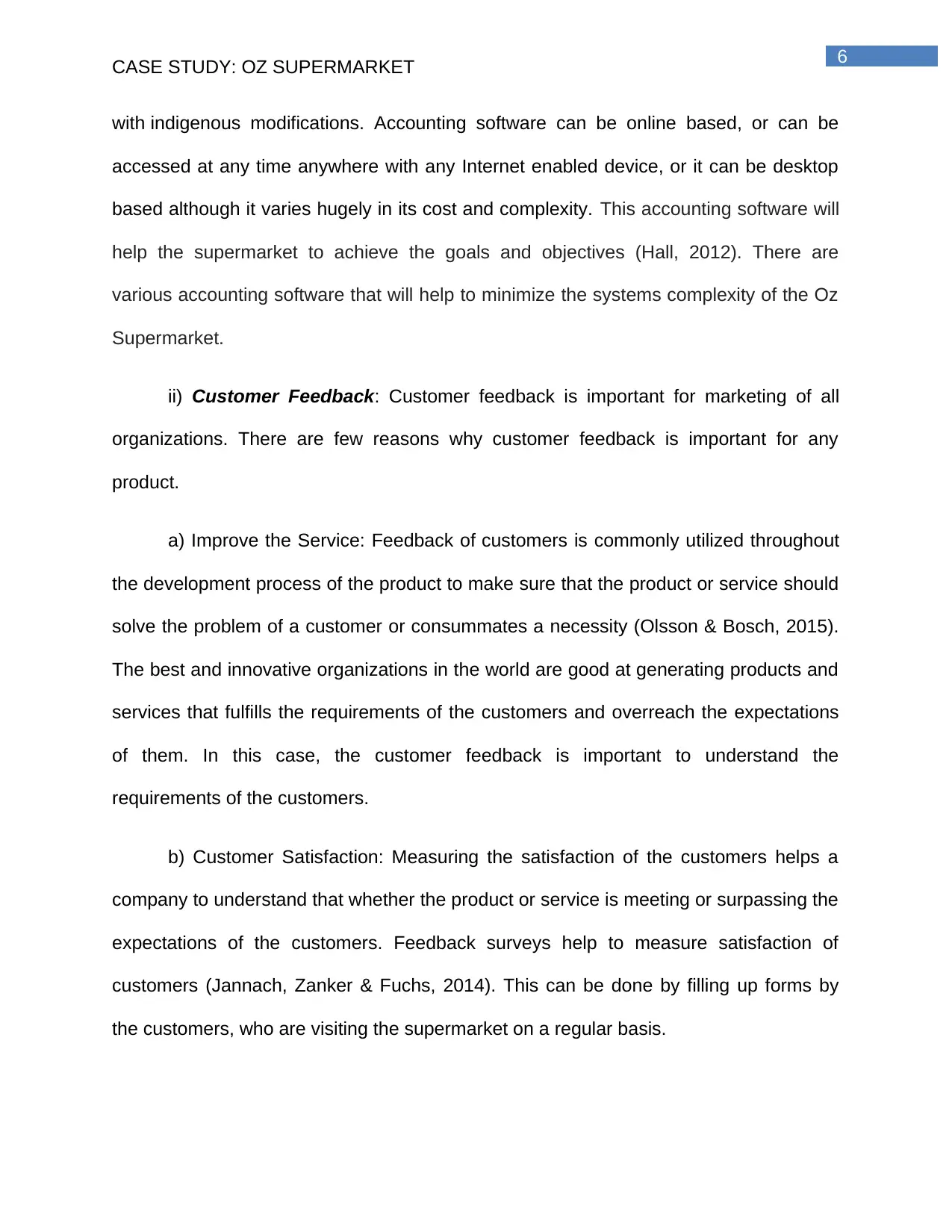
6
CASE STUDY: OZ SUPERMARKET
with indigenous modifications. Accounting software can be online based, or can be
accessed at any time anywhere with any Internet enabled device, or it can be desktop
based although it varies hugely in its cost and complexity. This accounting software will
help the supermarket to achieve the goals and objectives (Hall, 2012). There are
various accounting software that will help to minimize the systems complexity of the Oz
Supermarket.
ii) Customer Feedback: Customer feedback is important for marketing of all
organizations. There are few reasons why customer feedback is important for any
product.
a) Improve the Service: Feedback of customers is commonly utilized throughout
the development process of the product to make sure that the product or service should
solve the problem of a customer or consummates a necessity (Olsson & Bosch, 2015).
The best and innovative organizations in the world are good at generating products and
services that fulfills the requirements of the customers and overreach the expectations
of them. In this case, the customer feedback is important to understand the
requirements of the customers.
b) Customer Satisfaction: Measuring the satisfaction of the customers helps a
company to understand that whether the product or service is meeting or surpassing the
expectations of the customers. Feedback surveys help to measure satisfaction of
customers (Jannach, Zanker & Fuchs, 2014). This can be done by filling up forms by
the customers, who are visiting the supermarket on a regular basis.
CASE STUDY: OZ SUPERMARKET
with indigenous modifications. Accounting software can be online based, or can be
accessed at any time anywhere with any Internet enabled device, or it can be desktop
based although it varies hugely in its cost and complexity. This accounting software will
help the supermarket to achieve the goals and objectives (Hall, 2012). There are
various accounting software that will help to minimize the systems complexity of the Oz
Supermarket.
ii) Customer Feedback: Customer feedback is important for marketing of all
organizations. There are few reasons why customer feedback is important for any
product.
a) Improve the Service: Feedback of customers is commonly utilized throughout
the development process of the product to make sure that the product or service should
solve the problem of a customer or consummates a necessity (Olsson & Bosch, 2015).
The best and innovative organizations in the world are good at generating products and
services that fulfills the requirements of the customers and overreach the expectations
of them. In this case, the customer feedback is important to understand the
requirements of the customers.
b) Customer Satisfaction: Measuring the satisfaction of the customers helps a
company to understand that whether the product or service is meeting or surpassing the
expectations of the customers. Feedback surveys help to measure satisfaction of
customers (Jannach, Zanker & Fuchs, 2014). This can be done by filling up forms by
the customers, who are visiting the supermarket on a regular basis.
Paraphrase This Document
Need a fresh take? Get an instant paraphrase of this document with our AI Paraphraser
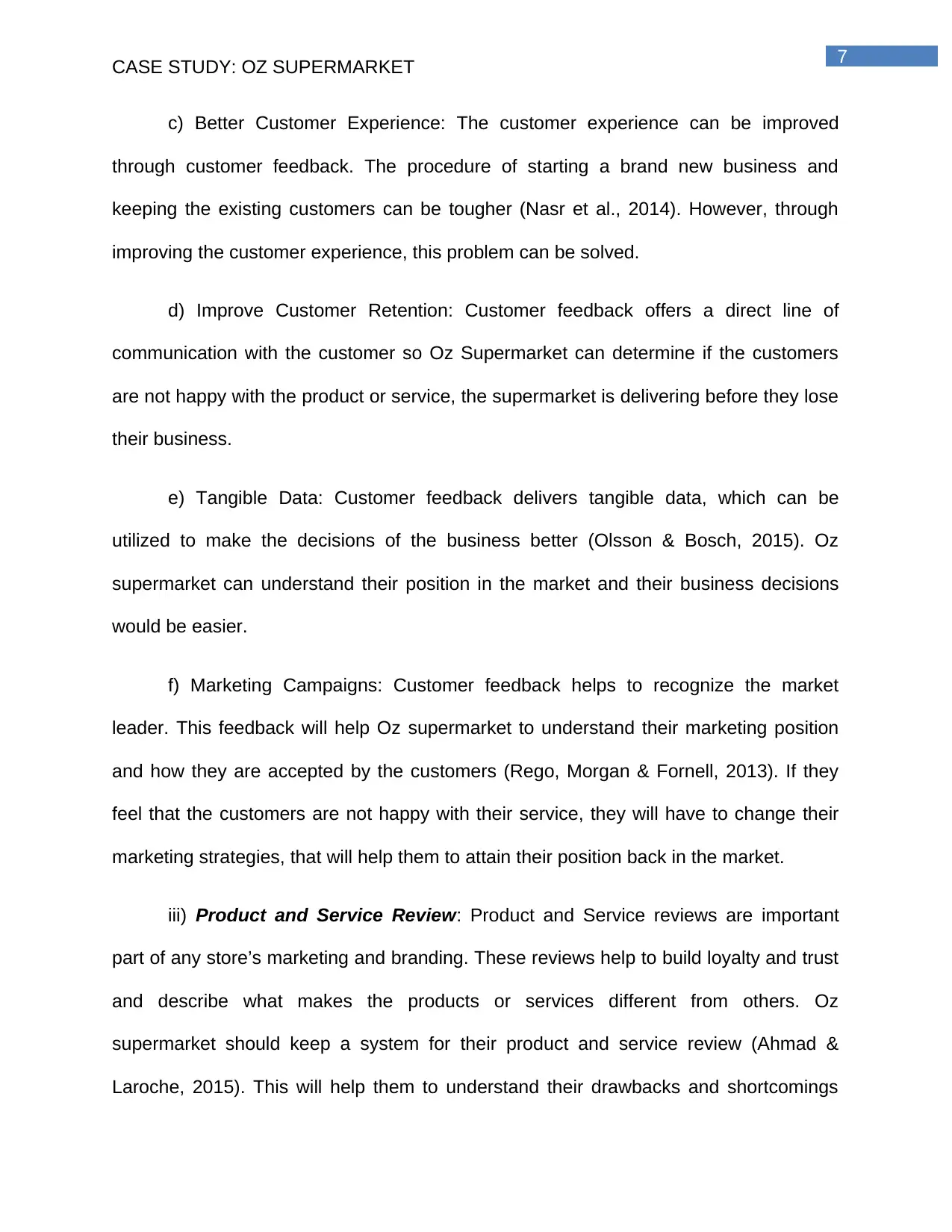
7
CASE STUDY: OZ SUPERMARKET
c) Better Customer Experience: The customer experience can be improved
through customer feedback. The procedure of starting a brand new business and
keeping the existing customers can be tougher (Nasr et al., 2014). However, through
improving the customer experience, this problem can be solved.
d) Improve Customer Retention: Customer feedback offers a direct line of
communication with the customer so Oz Supermarket can determine if the customers
are not happy with the product or service, the supermarket is delivering before they lose
their business.
e) Tangible Data: Customer feedback delivers tangible data, which can be
utilized to make the decisions of the business better (Olsson & Bosch, 2015). Oz
supermarket can understand their position in the market and their business decisions
would be easier.
f) Marketing Campaigns: Customer feedback helps to recognize the market
leader. This feedback will help Oz supermarket to understand their marketing position
and how they are accepted by the customers (Rego, Morgan & Fornell, 2013). If they
feel that the customers are not happy with their service, they will have to change their
marketing strategies, that will help them to attain their position back in the market.
iii) Product and Service Review: Product and Service reviews are important
part of any store’s marketing and branding. These reviews help to build loyalty and trust
and describe what makes the products or services different from others. Oz
supermarket should keep a system for their product and service review (Ahmad &
Laroche, 2015). This will help them to understand their drawbacks and shortcomings
CASE STUDY: OZ SUPERMARKET
c) Better Customer Experience: The customer experience can be improved
through customer feedback. The procedure of starting a brand new business and
keeping the existing customers can be tougher (Nasr et al., 2014). However, through
improving the customer experience, this problem can be solved.
d) Improve Customer Retention: Customer feedback offers a direct line of
communication with the customer so Oz Supermarket can determine if the customers
are not happy with the product or service, the supermarket is delivering before they lose
their business.
e) Tangible Data: Customer feedback delivers tangible data, which can be
utilized to make the decisions of the business better (Olsson & Bosch, 2015). Oz
supermarket can understand their position in the market and their business decisions
would be easier.
f) Marketing Campaigns: Customer feedback helps to recognize the market
leader. This feedback will help Oz supermarket to understand their marketing position
and how they are accepted by the customers (Rego, Morgan & Fornell, 2013). If they
feel that the customers are not happy with their service, they will have to change their
marketing strategies, that will help them to attain their position back in the market.
iii) Product and Service Review: Product and Service reviews are important
part of any store’s marketing and branding. These reviews help to build loyalty and trust
and describe what makes the products or services different from others. Oz
supermarket should keep a system for their product and service review (Ahmad &
Laroche, 2015). This will help them to understand their drawbacks and shortcomings
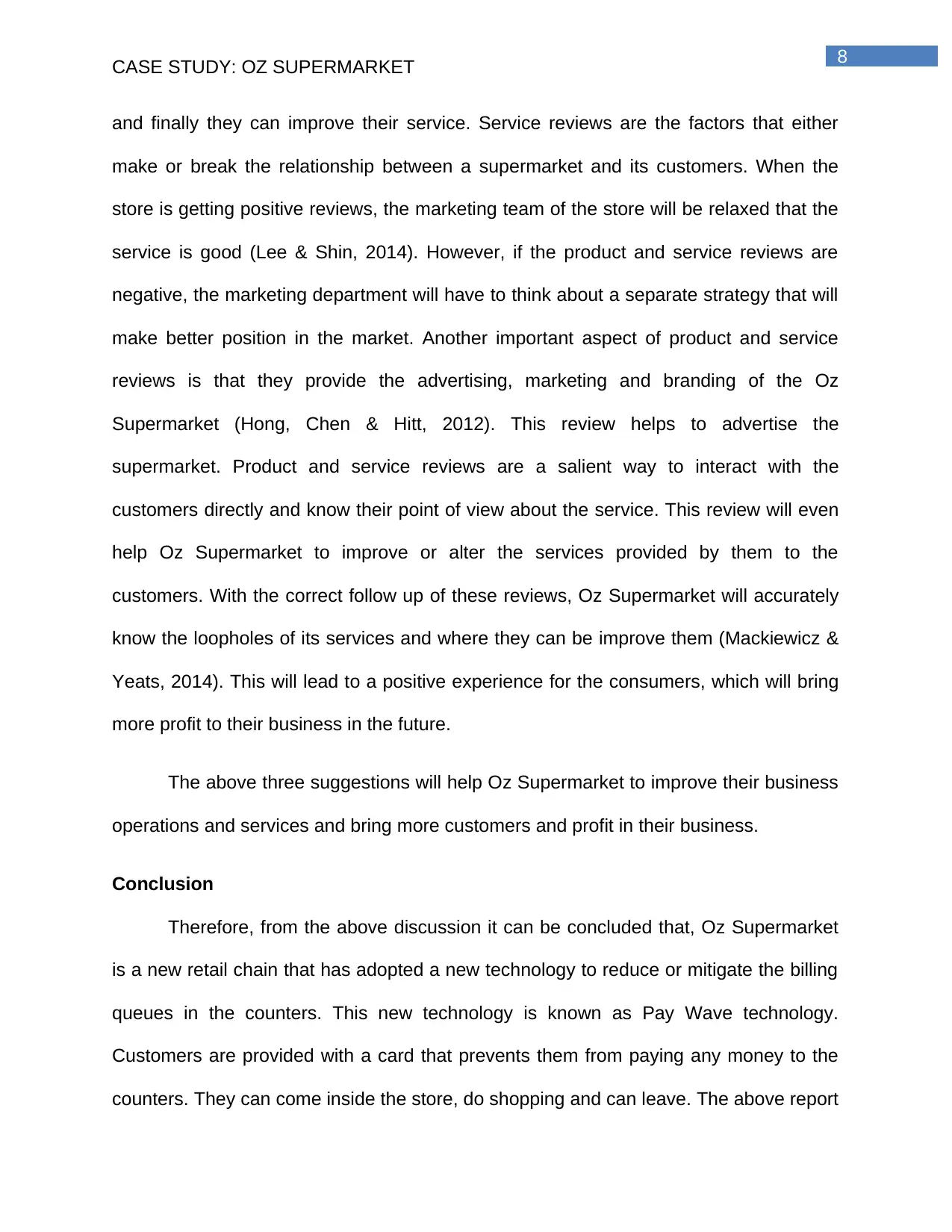
8
CASE STUDY: OZ SUPERMARKET
and finally they can improve their service. Service reviews are the factors that either
make or break the relationship between a supermarket and its customers. When the
store is getting positive reviews, the marketing team of the store will be relaxed that the
service is good (Lee & Shin, 2014). However, if the product and service reviews are
negative, the marketing department will have to think about a separate strategy that will
make better position in the market. Another important aspect of product and service
reviews is that they provide the advertising, marketing and branding of the Oz
Supermarket (Hong, Chen & Hitt, 2012). This review helps to advertise the
supermarket. Product and service reviews are a salient way to interact with the
customers directly and know their point of view about the service. This review will even
help Oz Supermarket to improve or alter the services provided by them to the
customers. With the correct follow up of these reviews, Oz Supermarket will accurately
know the loopholes of its services and where they can be improve them (Mackiewicz &
Yeats, 2014). This will lead to a positive experience for the consumers, which will bring
more profit to their business in the future.
The above three suggestions will help Oz Supermarket to improve their business
operations and services and bring more customers and profit in their business.
Conclusion
Therefore, from the above discussion it can be concluded that, Oz Supermarket
is a new retail chain that has adopted a new technology to reduce or mitigate the billing
queues in the counters. This new technology is known as Pay Wave technology.
Customers are provided with a card that prevents them from paying any money to the
counters. They can come inside the store, do shopping and can leave. The above report
CASE STUDY: OZ SUPERMARKET
and finally they can improve their service. Service reviews are the factors that either
make or break the relationship between a supermarket and its customers. When the
store is getting positive reviews, the marketing team of the store will be relaxed that the
service is good (Lee & Shin, 2014). However, if the product and service reviews are
negative, the marketing department will have to think about a separate strategy that will
make better position in the market. Another important aspect of product and service
reviews is that they provide the advertising, marketing and branding of the Oz
Supermarket (Hong, Chen & Hitt, 2012). This review helps to advertise the
supermarket. Product and service reviews are a salient way to interact with the
customers directly and know their point of view about the service. This review will even
help Oz Supermarket to improve or alter the services provided by them to the
customers. With the correct follow up of these reviews, Oz Supermarket will accurately
know the loopholes of its services and where they can be improve them (Mackiewicz &
Yeats, 2014). This will lead to a positive experience for the consumers, which will bring
more profit to their business in the future.
The above three suggestions will help Oz Supermarket to improve their business
operations and services and bring more customers and profit in their business.
Conclusion
Therefore, from the above discussion it can be concluded that, Oz Supermarket
is a new retail chain that has adopted a new technology to reduce or mitigate the billing
queues in the counters. This new technology is known as Pay Wave technology.
Customers are provided with a card that prevents them from paying any money to the
counters. They can come inside the store, do shopping and can leave. The above report
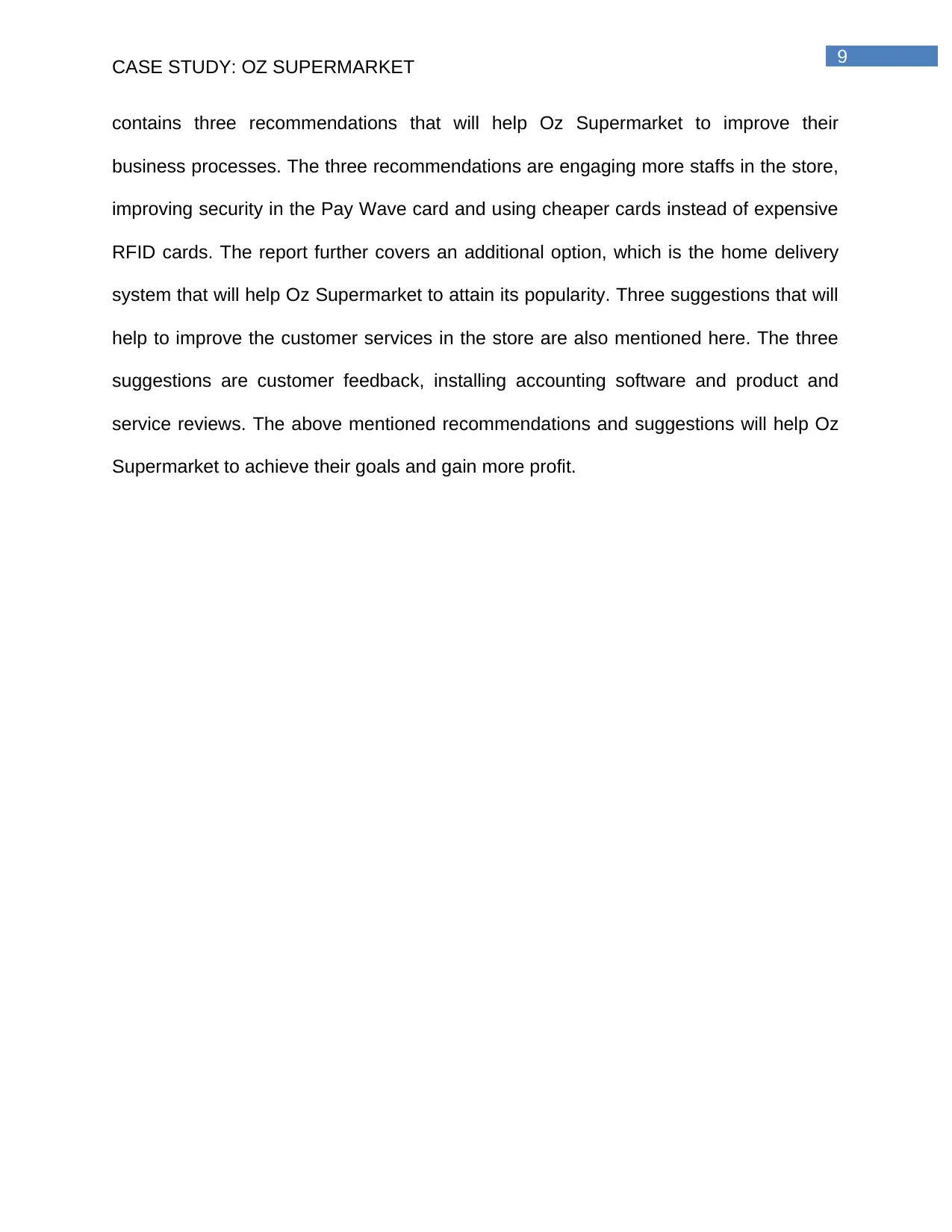
9
CASE STUDY: OZ SUPERMARKET
contains three recommendations that will help Oz Supermarket to improve their
business processes. The three recommendations are engaging more staffs in the store,
improving security in the Pay Wave card and using cheaper cards instead of expensive
RFID cards. The report further covers an additional option, which is the home delivery
system that will help Oz Supermarket to attain its popularity. Three suggestions that will
help to improve the customer services in the store are also mentioned here. The three
suggestions are customer feedback, installing accounting software and product and
service reviews. The above mentioned recommendations and suggestions will help Oz
Supermarket to achieve their goals and gain more profit.
CASE STUDY: OZ SUPERMARKET
contains three recommendations that will help Oz Supermarket to improve their
business processes. The three recommendations are engaging more staffs in the store,
improving security in the Pay Wave card and using cheaper cards instead of expensive
RFID cards. The report further covers an additional option, which is the home delivery
system that will help Oz Supermarket to attain its popularity. Three suggestions that will
help to improve the customer services in the store are also mentioned here. The three
suggestions are customer feedback, installing accounting software and product and
service reviews. The above mentioned recommendations and suggestions will help Oz
Supermarket to achieve their goals and gain more profit.
Secure Best Marks with AI Grader
Need help grading? Try our AI Grader for instant feedback on your assignments.
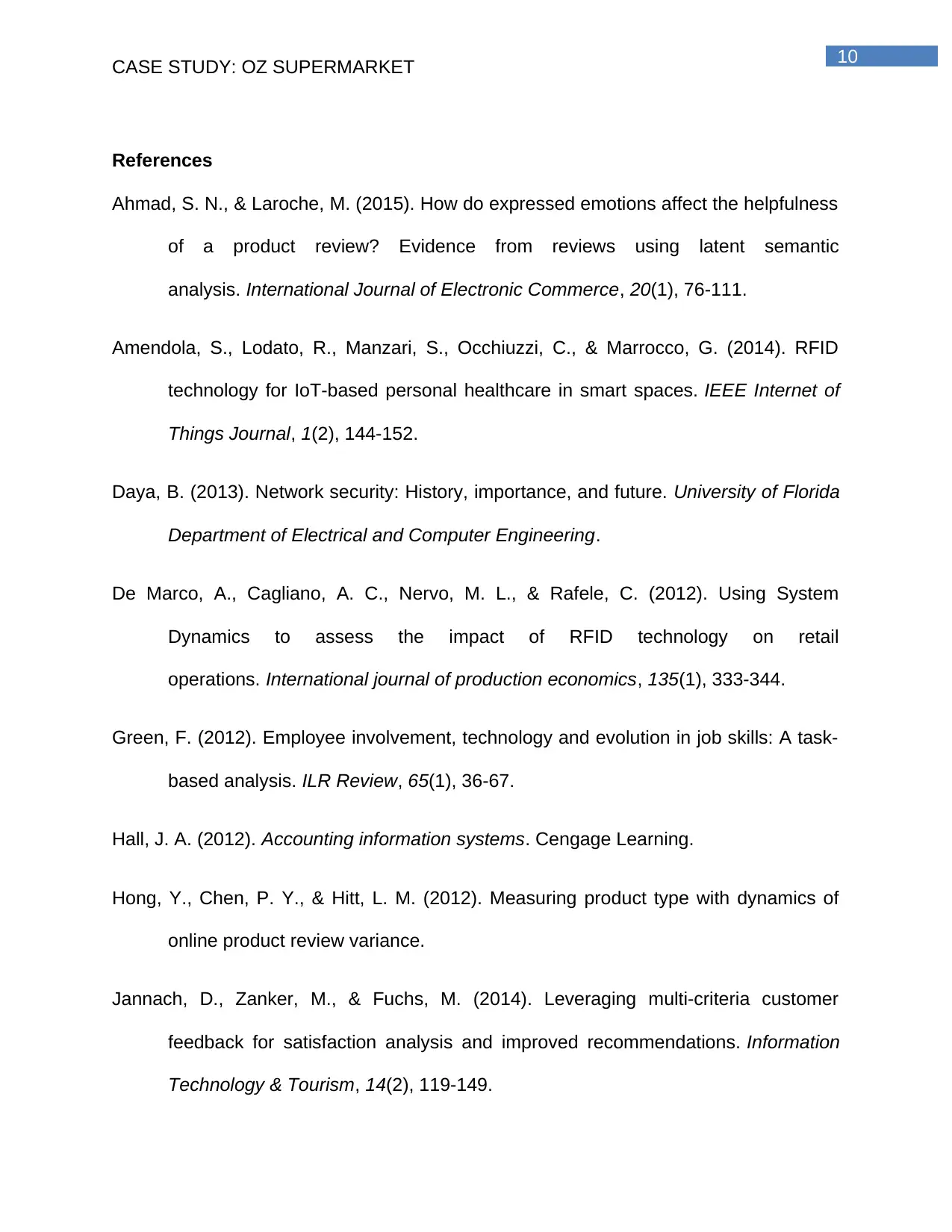
10
CASE STUDY: OZ SUPERMARKET
References
Ahmad, S. N., & Laroche, M. (2015). How do expressed emotions affect the helpfulness
of a product review? Evidence from reviews using latent semantic
analysis. International Journal of Electronic Commerce, 20(1), 76-111.
Amendola, S., Lodato, R., Manzari, S., Occhiuzzi, C., & Marrocco, G. (2014). RFID
technology for IoT-based personal healthcare in smart spaces. IEEE Internet of
Things Journal, 1(2), 144-152.
Daya, B. (2013). Network security: History, importance, and future. University of Florida
Department of Electrical and Computer Engineering.
De Marco, A., Cagliano, A. C., Nervo, M. L., & Rafele, C. (2012). Using System
Dynamics to assess the impact of RFID technology on retail
operations. International journal of production economics, 135(1), 333-344.
Green, F. (2012). Employee involvement, technology and evolution in job skills: A task-
based analysis. ILR Review, 65(1), 36-67.
Hall, J. A. (2012). Accounting information systems. Cengage Learning.
Hong, Y., Chen, P. Y., & Hitt, L. M. (2012). Measuring product type with dynamics of
online product review variance.
Jannach, D., Zanker, M., & Fuchs, M. (2014). Leveraging multi-criteria customer
feedback for satisfaction analysis and improved recommendations. Information
Technology & Tourism, 14(2), 119-149.
CASE STUDY: OZ SUPERMARKET
References
Ahmad, S. N., & Laroche, M. (2015). How do expressed emotions affect the helpfulness
of a product review? Evidence from reviews using latent semantic
analysis. International Journal of Electronic Commerce, 20(1), 76-111.
Amendola, S., Lodato, R., Manzari, S., Occhiuzzi, C., & Marrocco, G. (2014). RFID
technology for IoT-based personal healthcare in smart spaces. IEEE Internet of
Things Journal, 1(2), 144-152.
Daya, B. (2013). Network security: History, importance, and future. University of Florida
Department of Electrical and Computer Engineering.
De Marco, A., Cagliano, A. C., Nervo, M. L., & Rafele, C. (2012). Using System
Dynamics to assess the impact of RFID technology on retail
operations. International journal of production economics, 135(1), 333-344.
Green, F. (2012). Employee involvement, technology and evolution in job skills: A task-
based analysis. ILR Review, 65(1), 36-67.
Hall, J. A. (2012). Accounting information systems. Cengage Learning.
Hong, Y., Chen, P. Y., & Hitt, L. M. (2012). Measuring product type with dynamics of
online product review variance.
Jannach, D., Zanker, M., & Fuchs, M. (2014). Leveraging multi-criteria customer
feedback for satisfaction analysis and improved recommendations. Information
Technology & Tourism, 14(2), 119-149.
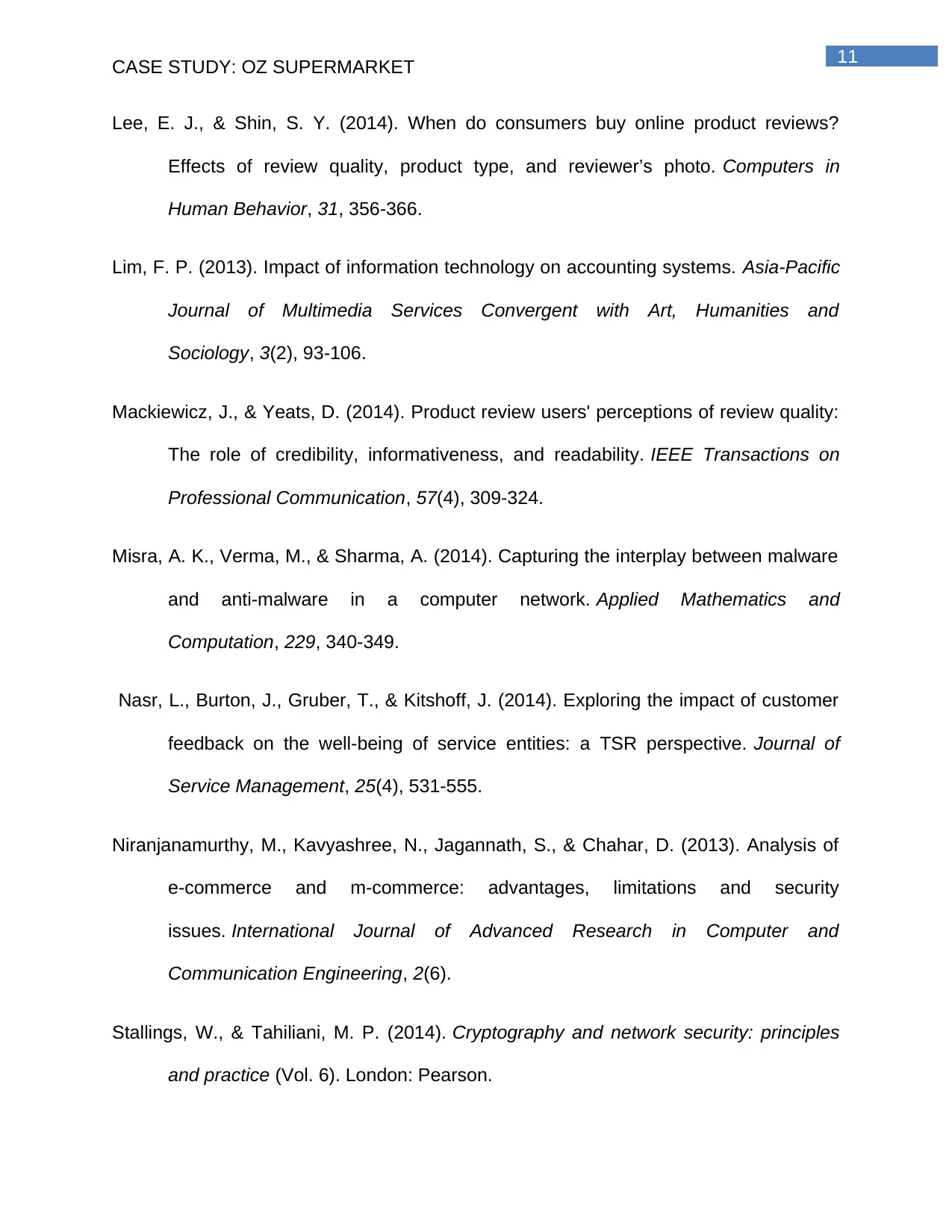
11
CASE STUDY: OZ SUPERMARKET
Lee, E. J., & Shin, S. Y. (2014). When do consumers buy online product reviews?
Effects of review quality, product type, and reviewer’s photo. Computers in
Human Behavior, 31, 356-366.
Lim, F. P. (2013). Impact of information technology on accounting systems. Asia-Pacific
Journal of Multimedia Services Convergent with Art, Humanities and
Sociology, 3(2), 93-106.
Mackiewicz, J., & Yeats, D. (2014). Product review users' perceptions of review quality:
The role of credibility, informativeness, and readability. IEEE Transactions on
Professional Communication, 57(4), 309-324.
Misra, A. K., Verma, M., & Sharma, A. (2014). Capturing the interplay between malware
and anti-malware in a computer network. Applied Mathematics and
Computation, 229, 340-349.
Nasr, L., Burton, J., Gruber, T., & Kitshoff, J. (2014). Exploring the impact of customer
feedback on the well-being of service entities: a TSR perspective. Journal of
Service Management, 25(4), 531-555.
Niranjanamurthy, M., Kavyashree, N., Jagannath, S., & Chahar, D. (2013). Analysis of
e-commerce and m-commerce: advantages, limitations and security
issues. International Journal of Advanced Research in Computer and
Communication Engineering, 2(6).
Stallings, W., & Tahiliani, M. P. (2014). Cryptography and network security: principles
and practice (Vol. 6). London: Pearson.
CASE STUDY: OZ SUPERMARKET
Lee, E. J., & Shin, S. Y. (2014). When do consumers buy online product reviews?
Effects of review quality, product type, and reviewer’s photo. Computers in
Human Behavior, 31, 356-366.
Lim, F. P. (2013). Impact of information technology on accounting systems. Asia-Pacific
Journal of Multimedia Services Convergent with Art, Humanities and
Sociology, 3(2), 93-106.
Mackiewicz, J., & Yeats, D. (2014). Product review users' perceptions of review quality:
The role of credibility, informativeness, and readability. IEEE Transactions on
Professional Communication, 57(4), 309-324.
Misra, A. K., Verma, M., & Sharma, A. (2014). Capturing the interplay between malware
and anti-malware in a computer network. Applied Mathematics and
Computation, 229, 340-349.
Nasr, L., Burton, J., Gruber, T., & Kitshoff, J. (2014). Exploring the impact of customer
feedback on the well-being of service entities: a TSR perspective. Journal of
Service Management, 25(4), 531-555.
Niranjanamurthy, M., Kavyashree, N., Jagannath, S., & Chahar, D. (2013). Analysis of
e-commerce and m-commerce: advantages, limitations and security
issues. International Journal of Advanced Research in Computer and
Communication Engineering, 2(6).
Stallings, W., & Tahiliani, M. P. (2014). Cryptography and network security: principles
and practice (Vol. 6). London: Pearson.
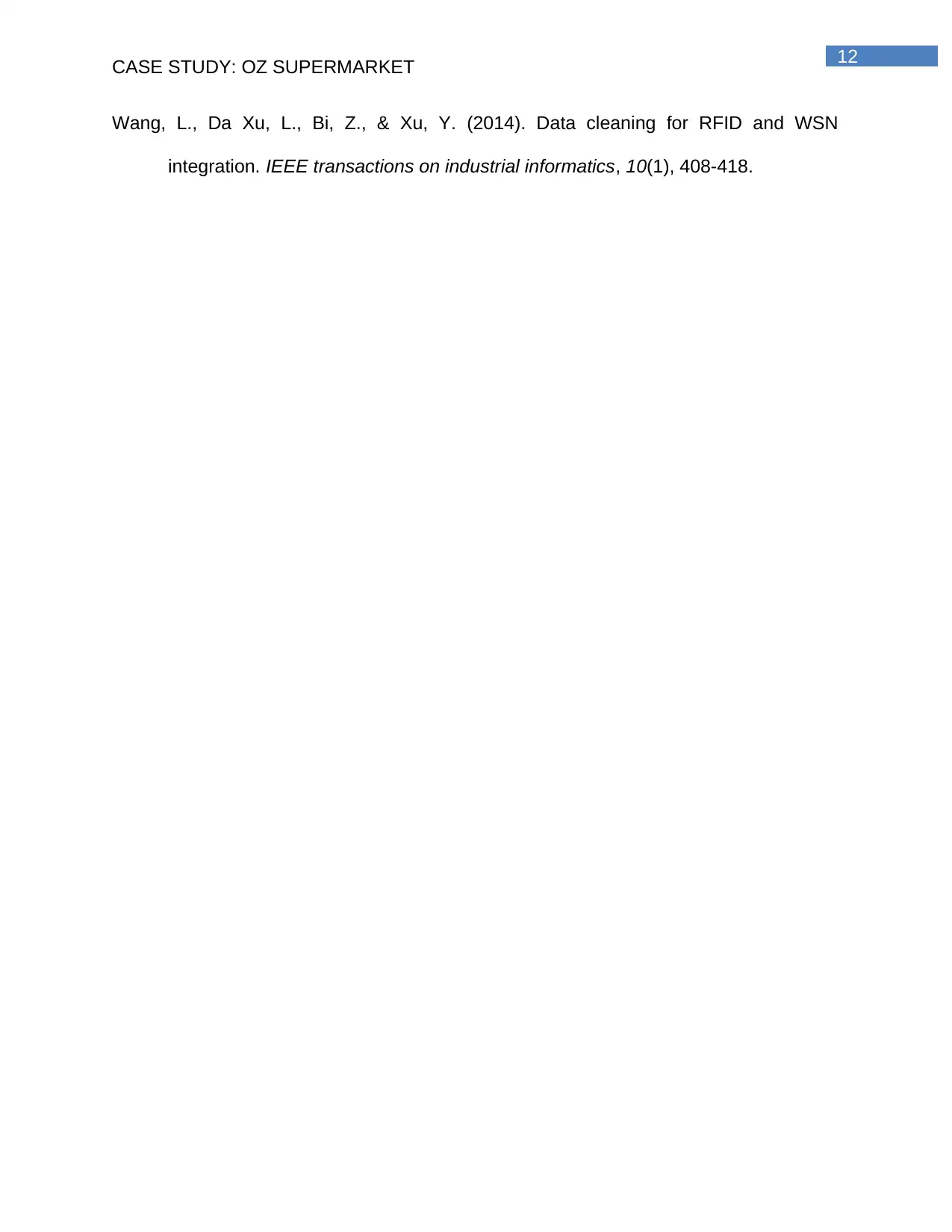
12
CASE STUDY: OZ SUPERMARKET
Wang, L., Da Xu, L., Bi, Z., & Xu, Y. (2014). Data cleaning for RFID and WSN
integration. IEEE transactions on industrial informatics, 10(1), 408-418.
CASE STUDY: OZ SUPERMARKET
Wang, L., Da Xu, L., Bi, Z., & Xu, Y. (2014). Data cleaning for RFID and WSN
integration. IEEE transactions on industrial informatics, 10(1), 408-418.
1 out of 13
Related Documents
Your All-in-One AI-Powered Toolkit for Academic Success.
+13062052269
info@desklib.com
Available 24*7 on WhatsApp / Email
![[object Object]](/_next/static/media/star-bottom.7253800d.svg)
Unlock your academic potential
© 2024 | Zucol Services PVT LTD | All rights reserved.





